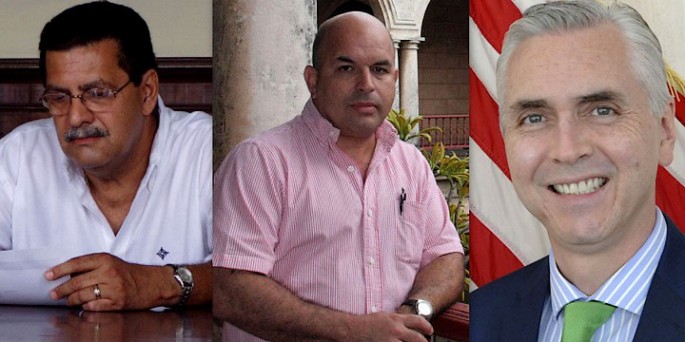
An unprecedented dialogue: A Cuban academician, a U.S. politician and a Catholic spokesman
HAVANA — On Sept. 9, 2014, a Prayer for Peace was conducted for the first time in Cuba, an inter-denominational and cultural event that brought together men and women of faith. Three months later, on the day of St. Lazarus, the reestablishment of relations between Havana and Washington was announced.
The Sant’Egidio Community, which organized the encounter, considers that announcement to be the most beautiful fruit of the Prayer. This month, it repeated the call on the 4th and 6th days, with the topic of U.S.-Cuba relations as the focus of the reflections.
Professor Jesús Arboleya; Scott Hamilton, Deputy Chief of Mission at the U.S. Embassy in Havana; and Orlando Márquez, spokesman for the Archdiocese of Havana, shared the stage.
A Cuban academician, a U.S. politician and a representative of the Catholic Church expressing their opinions from the same table paint a very infrequent image — almost unprecedented, one might say — and represent a positive metaphor for today’s times.
“The most relevant aspect of the new situation is that it chooses negotiation over confrontation and opens spaces for a constructive exchange on many issues, which is beneficial for both nations and could serve as a paradigm for international relations,” Arboleya summarized.
In his opinion, it is good that Cuba and the United States are talking of peace. Nevertheless, peace also has complications, especially because of the asymmetry of the parties and the wide range of contradictions acknowledged by both governments.
Within and without both frontiers, a favorable environment for the actual process of approximation predominates. More than support for the Cuban system, the international rejection of the United States’ hostile policy is related to the extraterritorial nature of that projection.
Meanwhile, a large part of the U.S. society has welcomed the change, boosting President Obama’s political capital.
“There is no space here for Manichean stances that demonize the new situation or assume that a relationship with the U.S. resolves, by itself, the problems of Cuba,” Arboleya says.
In that sense, the hottest issue is the assessment in the United States of the Cuban reality and the interest of some sectors in promoting a regime change on the island.
So, it’s worthwhile to remember that “the future of Cuba depends on us Cubans, and we have the advantage of being able to decide it by ourselves, with full national sovereignty,” Arboleya stressed.
Hamilton shared “10 lessons” that, in his opinion, the dialogue has taught: diplomacy is indeed important; time is the key; discretion is important; so is collaboration with friends; interests and appreciations are different; one must think creatively and be patient, etc.
“In diplomacy, issues sometimes move at the speed of trust,” the U.S. diplomat said. “Remember that normalization is a process, not an event. Normalization will take time.”
Taking as a direct reference “the American dream,” Hamilton commented that, in the future, the Cuban government and citizens will have to quickly define the contents of “the Cuban dream.”
Words are important, he said, ergo, a transplantation of the concept — with all its symbols — is not necessarily the best recommendation. A social project, or a national project, is how we say it here.
Hamilton acknowledged that the Cuban-American community is experiencing a notable transformation in its outlook on Cuba. The great majority sees the former policy as a relic of the Cold War and significantly supports the bilateral links.
“The American and Cuban peoples will have an opportunity to know each other better and share their different experiences. We believe that this will lead to a more constructive relation between our countries and peoples,” he said.
Orlando Márquez, spokesman for the Archdiocese of Havana, said that the appreciation expressed by presidents Obama and Raúl Castro for Pope Francis’ mediation in the negotiations is an acknowledgment that the mission of the Church is not exclusive to the interior of a temple.
Márquez, editor of the magazine Palabra Nueva, said that for decades the Cuban Church and the U.S. Episcopal Conference advocated an improvement in relations between the two countries, and he cited several documents where the bishops called for conciliation and understanding.
“The Church can do much more; what the Pope did is an example,” he said. “It is not a matter of becoming involved in politics; it’s a matter of calling attention to the conflicts that the politicians must resolve, which is a different issue.
“The Church is also co-responsible — along with other institutions — for the present and future of society, and it wants to be a part of that. It doesn’t hope for greater powers; it simply wants to be a part of the solution and contribute with its effort to the improvement of society.”
Last Sunday, the Prayer for Peace ended with prayers by representatives of the various religions: Christians, Buddhists, Muslims and Jews. At the end, all staged a procession to the St. Francis of Assisi Square.
“Peace is always possible” was the motto of the meeting. May it be so.
[Photo at top, from left to right, of Jesus Arboleya, Orlando Marquéz and Scott Hamilton.]
Progreso Weekly authorizes the total or partial reproduction of the articles by our journalists, so long as source and author are identified.

